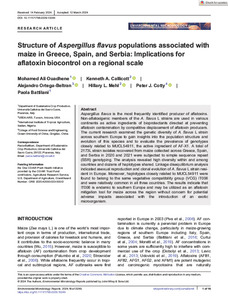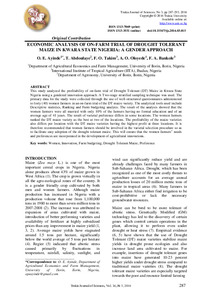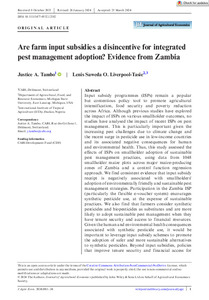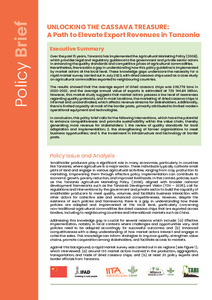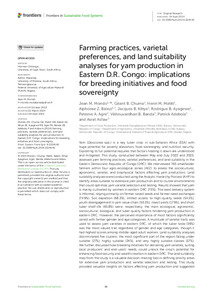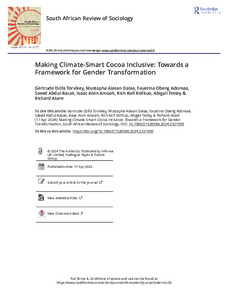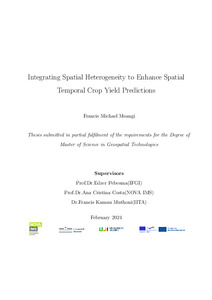Welcome to the International Institute of Tropical Agriculture Research Repository
IITA Bibliography System: Recent submissions
Now showing items 161-180 of 8094
-
Climate change adaptation strategies and its impact on household vulnerability to food insecurity: a micro-level evidence from Southwest Ethiopia
(2024-07-06)Smallholder farmers in Ethiopia face increasing challenges from climate change and variability, which threaten their food security and livelihoods. This study examines how adopting single and combined climate change adaptation practices affects their vulnerability to food insecurity in Bench Maji Zone, southwest Ethiopia. Through multistage sampling, data was gathered from 390 rural households in four climate-prone districts. The study examines the impacts resulting from both individual and combined ... -
Structure of Aspergillus flavus populations associated with maize in Greece, Spain, and Serbia: implications for aflatoxin biocontrol on a regional scale
(2024-04)Aspergillus flavus is the most frequently identified producer of aflatoxins. Non-aflatoxigenic members of the A. flavus L strains are used in various continents as active ingredients of bioprotectants directed at preventing aflatoxin contamination by competitive displacement of aflatoxin producers. The current research examined the genetic diversity of A. flavus L strain across southern Europe to gain insights into the population structure and evolution of this species and to evaluate the prevalence ... -
Economic analysis of on-farm trial of drought tolerant maize in Kwara state Nigeria: a gender approach
(2016-01)This study analyzed the profitability of on-farm trial of Drought Tolerant (DT) Maize in Kwara State Nigeria using a gendered innovation approach. A Two-stage stratified sampling technique was used. The primary data for the study were collected through the use of well-structured questionnaires administered to forty (40) women farmers in an on-farm trial of the DT maize variety. The analytical tools used include Descriptive statistics, Ranking and Farm budgeting analysis. The result of the analysis ... -
Are farm input subsidies a disincentive for integrated pest management adoption? Evidence from Zambia
(2024-04-23)Input subsidy programmes (ISPs) remain a popular but contentious policy tool to promote agricultural intensification, food security and poverty reduction across Africa. Although previous studies have explored the impact of ISPs on various smallholder outcomes, no studies have analysed the impact of recent ISPs on pest management. This is particularly important given the increasing pest challenges due to climate change and the recent surge in pesticide use in low-income countries and its associated ... -
Making genome editing a success story in Africa
(2024-03) -
Unlocking the cassava treasure: a path to elevate export revenues in Tanzania
(International Institute of Tropical Agriculture, 2024)Over the past 15 years, Tanzania has implemented the Agricultural Marketing Policy (2008), which provides legal and regulatory guidance to the government and private sector actors in enhancing the quality standards and competitive prices of agricultural commodities. Nevertheless, there exists a gap in understanding how this policy guideline is implemented by market actors at the local level. These knowledge gaps underscore the necessity for a rapid market survey carried out in July 2023, with ... -
Farming practices, varietal preferences, and land suitability analyses for yam production in Eastern D.R. Congo: implications for breeding initiatives and food sovereignty
(2024)Yam (Dioscorea spp.) is a key tuber crop in sub-Saharan Africa (SSA) with huge potential for poverty alleviation, food sovereignty, and nutrition security. Exploiting its full potential requires that factors holding it down are understood and mitigated. This study, conducted between May and July 2022 and 2023, assessed yam farming practices, varietal preferences, and land suitability in the Eastern Democratic Republic of Congo (DRC). We interviewed 765 smallholder farmers within four agro-ecological ... -
Smallholder farmers' willingness to pay for two-wheel tractor-based mechanisation services in Zambia and Zimbabwe
(2023)Mechanisation is back among top development policy priorities for transforming African smallholder agriculture. Yet previous and ongoing efforts ubiquitously suffer from lack of scientific information on end-user effective demand for different types of mechanical innovations to inform public investment or business development programmes. We assess smallholder farmers' willingness to pay (WTP) for two-wheel tractor (2WT)-based ripping, direct seeding and transportation using a random sample of 2800 ... -
National food consumption and micronutrient survey 2021: final report
(Federal Government of Nigeria and International Institute of Tropical Agriculture, 2024-01)The last National Food Consumption and Micronutrient Survey (NFCMS) was undertaken about 20 years ago in 2001 (Maziya-Dixon, et al., 2004; Nigeria Food Consumption and Nutrition Survey 2001- 2003, IITA, https://hdl.handle.net/10568/100010). The findings of that study likely no longer represent the current micronutrient status or dietary consumption patterns of the Nigerian population. This lack of recent and reliable information presents several challenges, both in terms of reviewing ongoing ... -
National food consumption and micronutrient survey 2021: key findings
(International Institute of Tropical Agriculture, 2024-01) -
Promoting youth engagement in agriculture through land titling programs: evidence from Tanzania
(2024-04-15)In many African countries, land access and tenure insecurity pose significant challenges to agriculture, in particular for the youth. As the farming population ages, young people are expected to take over, but they don’t often show much interest in farming, which could harm the future of agriculture in Africa, where the population is the youngest. Land reforms and titling programs are suggested as amongst strategies to make agriculture more attractive to investors and promote youth involvement. ... -
Agricultural transformation through wheat: an outcome evaluation of TAAT wheat compact’s interventions in Ethiopia
(Technologies for African Agricultural Transformation, 2023) -
Soil quality reflects microbial resource availability and drives rhizosphere microbiome variation in Ghanaian cocoa farms
(2024-06)Cocoa (Theobroma cacao L.) is an important crop in Ghana and the source of livelihood for hundreds of thousands of smallholder farmers. Maintaining soil quality on these farms is critical to ensuring the long-term viability of cocoa farming and preventing deforestation to meet rising demand. However, increasing attention to soil health has revealed a significant knowledge gap related to the soil microbiome in cocoa production systems. Using a nested design of sixteen smallholder cocoa farms in ... -
Elite genotypes of water yam (Dioscorea alata) yield food product quality comparable to white yam (Dioscorea rotundata)
(2024-04-26)Water yam (Dioscorea alata), also known as winged yam, is one of the most economically significant yam species, serving as a staple food crop in tropical and subtropical regions. Its widespread cultivation is due to its favorable agronomic characteristics, including high yield, improved tuber storability, and significant nutritional and health benefits. Despite these advantages, water yam often remains underutilized due to consumer biases towards its traditional food product quality, particularly ... -
Matching cereal and legume crop varieties to production environments in Northeast Nigeria using Decision Support Tools (DST)
(International Institute of Tropical Agriculture, 2024) -
Making climate-smart cocoa inclusive: towards a framework for gender transformation
(2024)Climate-Smart Cocoa (CSC), a strategic offshoot of the wider Climate-Smart Agriculture, is gaining ground in Ghana, a cocoa export-dependent country. CSC is imperative, given the rapidly declining forests, prolonged periods of drought, pest and disease infestations, and fluctuating cocoa yields attributed to climate variability and change. Although many interventions are instituted to restore sustainable cocoa production, they are largely technicist because they do not pay attention to gender ... -
The pattern of genetic variability in a core collection of 2,021 cowpea accessions
(2024-05-06)Cowpea is a highly drought-adapted leguminous crop with great promise for improving agricultural sustainability and food security. Here, we report analyses derived from array-based genotyping of 2,021 accessions constituting a core subset of the world's largest cowpea collection, held at the International Institute of Tropical Agriculture (IITA) in Ibadan, Nigeria. We used this dataset to examine genetic variation and population structure in worldwide cowpea. We confirm that the primary pattern ... -
Introduction: climate, cocoa and trees
(Springer, 2023-12-30)Climate change is predicted to significantly reduce areas suitable for the cultivation of cocoa, an important cash crop providing a livelihood to over six million smallholders in the humid tropics. Cocoa agroforestry shows potential to increase climate resilience while providing more stable incomes, enhancing biodiversity, supporting healthy ecosystems and reducing the pace at which farms expand into forested areas. Based on the multidisciplinary ‘Climate Smart Cocoa Systems for Ghana’ research ... -
Integrating spatial heterogeneity to enhance spatial temporal crop yield predictions
(Universidade NOVA de Lisboa, 2024-02)Crop yield predictions and monitoring are important in understanding key challenges in crop production and management to ensure the effective utilization of resources to enhance food security. Over the years remote sensing data and machine learning models have been employed with the help of ground truth data as reference in the estimation of crop yields across space and time. However, the common machine learning methods often overlook the spatial heterogeneity inherent in regions leading to ...


